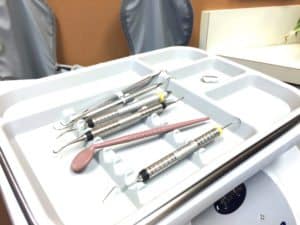
Imagine if the going rate for your iPad 2 was $100 trillion. Apart from costing five times the GDP of the United States, such a device would be almost impossible to manufacture in a sustainable manner. In the 1940s, however, the technology needed to power that type of machine would have cost this exact amount per this Brookings Institution analysis.
 So, what’s changed in the last 80 or so years? Well, the Second World War ended, we put a man on the moon, and industry costs have dropped dramatically, following the Moore’s Law. As prices dropped, innovation proliferated. Today, the technology that brings us things like Gmail or Venmo is the result of a declining cost curve within a given industry – computing.
So, what’s changed in the last 80 or so years? Well, the Second World War ended, we put a man on the moon, and industry costs have dropped dramatically, following the Moore’s Law. As prices dropped, innovation proliferated. Today, the technology that brings us things like Gmail or Venmo is the result of a declining cost curve within a given industry – computing.
For investors, the connection between declining costs and technological leaps is important. It lends an opportunity to spot upticks in other industries.
So, which industries are currently positioned for high investment return based on similarly declining cost curves?
Declining Gene Sequencing costs → Rise of Personalized Medicine
As with the price of the iPad 2, the cost of gene sequencing for a single human genome has dropped precipitously – from $100 million in 2001 to just over $1,000 today. Heres a chart from the National Human Genome Research Institute (NHGRI). Note the line indicating Moore’s Law, helpfully provided by the NHGRI. Gene Sequencing cost declines are much steeper than the cost declines in computing. This is quite incredible.
 What this means is: in the next few years, we will start to have incredibly fine grained individual genetic data at our fingertips. The immediate implication is that we will be able to personalize medical treatment to each individual’s unique needs. We fully expect personalized medicine to be a big trend. Indeed, it is happening already.
What this means is: in the next few years, we will start to have incredibly fine grained individual genetic data at our fingertips. The immediate implication is that we will be able to personalize medical treatment to each individual’s unique needs. We fully expect personalized medicine to be a big trend. Indeed, it is happening already.
Per the Personalized Medicine Coalition, in the past three years, more than 20% of the drugs approved by the FDA were categorized as personalized medicine, and 42% of the drugs currently under development are categorized as personalized medicine. This indicates immense potential for industry growth in the next 5-10 years. Growth that investors can capitalize on.
Some of the highest return investment opportunities will come from startups that use data to help physicians select therapies. These will not be companion diagnostics companies – these are expected to be more of AI companies, companions for the physician, that analyze each individual’s unique situation and help recommend therapies based on this data. Additionally, personalized therapies will be developed in the fields of gene therapies, cell therapies, tailored drug delivery mechanisms and others.
With such opportunities on the rise, it’s important to know how to sort through the herd. Any therapy based on copious amounts of genetic information will seem premier at first glance, but you’ll need to take a step back and ask: What is it that this company is basing their personalized therapies on? This is especially true because the promise of genetic information has not so far been borne out since many genes may or may not be expressed. In the end, the companies that yield the highest return are the ones that will factor in not just genetic information, but also individual lifestyles and medical history.
 Finally, sequencing costs are dropping not just for human genetic data but also for sequencing genomes of plants and animals. These will give rise to great opportunities in life sciences beyond human beings. Ways to grow more food, to protect our animals from deadly diseases, to safeguard our food supply chains.
Finally, sequencing costs are dropping not just for human genetic data but also for sequencing genomes of plants and animals. These will give rise to great opportunities in life sciences beyond human beings. Ways to grow more food, to protect our animals from deadly diseases, to safeguard our food supply chains.
We already see examples emerging: at my company we helped closed financing for SafeTraces – a company that uses Seaweed DNA as bar codes for food. Bar codes that are edible, odorless, colorless and hardy. Safetraces can create a new bar code by changing two base pairs in seaweed DNA. This is then sprayed on produce before packaging. Unique information is attached to this bar code including origin, time of picking etc. Produce is then sent out into the supply chain to be distributed via retailers. At any point, SafeTraces’ bar codes can be read by special readers that analyze the produce, and the origin of the produce can be identified down to the field and batch number. This can be huge, especially in light of the recent government food safety mandates.
Declining Energy Storage costs → Rise of Grid 2.0
Another industry that has seen huge cost declines is energy storage. Here is a chart from EPRI showing the decline in cost of Lithium – Ion batteries. To be noted that both Tesla and GM have declared that they are producing energy storage at even lower costs.
While the above chart shows costs of Li-ion batteries, the trend holds for energy storage technologies in general.
As energy storage become less and less expensive, the reality of a cleaner, more flexible, smarter grid comes closer – Grid 2.0 is on the horizon. Renewables will see greater integration, micro-grids are likely to become the norm and investments in micro-grid management systems are likely to deliver returns in the next decade.
 With cheaper and better energy storage, we will now be able to get off the grid for longer. Devices requiring a charge will last longer, cars will have greater range, and electric airplanes will replace jet fuel. Flying cars are already being tested and Amazon is testing delivery by drones. As with autonomous vehicles, we expect to see all of these devices proliferate in the next decade or so. These will also deliver some of the greatest returns in the next ten years.
With cheaper and better energy storage, we will now be able to get off the grid for longer. Devices requiring a charge will last longer, cars will have greater range, and electric airplanes will replace jet fuel. Flying cars are already being tested and Amazon is testing delivery by drones. As with autonomous vehicles, we expect to see all of these devices proliferate in the next decade or so. These will also deliver some of the greatest returns in the next ten years.
Finally, despite costs having declined significantly, novel energy storage technologies are now more interesting than ever before. As we get off the grid more and more, we will need different technologies for different applications. Power density, energy density, cost, life span – all of these are considerations for specific applications.
One novel technology that we hosted is Seatrec. This company is able to harvest energy from small temperature differentials and store it. This is not your run of the mill thermo-electric system. Instead, it stores small temperature differentials as volume changes in Phase Change Materials. This technology has been used to cleanly power ocean vehicles – using the temperature differential between upper reaches and lower levels of the oceans.
Decline in cost of Computing Power + Data proliferation → Rise of Artificial Intelligence
The final cost curve that I want to highlight is computing. As I pointed out earlier, costs of computing have declined dramatically. Add to that the fact that we are now producing enormous volumes of data. According to IBM, we produce 2.5 quintillion bytes of data every day. That’s one million trillions. Or one trillion millions. Or even…well, you get the point.
At the same time, we also have the technological capability to process all of that data.
As we become better and better at processing that data, we move ever closer to the age of Jarvis. Besides getting personalized home assistants with the voice of Iron Man, this means that AI is going to touch almost every part of our lives. It will have a big role within the industries previously discussed, be it in the form of selecting therapies based on your genetic data or managing the micro-grid.
While the forthcoming prevalence of AI is enticing to investors, you’ll need to be careful where you’re investing your money. Nowadays, almost every tech startup uses ‘AI’ and ‘ML’ in some capacity, so you need to have a look at the black box during diligence. Some of the industries that will yield greatest opportunities are those that produce the greatest amounts of data: life sciences, energy, financial services, defense, and consumer goods.
 One final comment on the growth of AI – it is going to be enabled by millions of distributed sensors as well as robotics. After all, Intelligence really consists of three parts – 1) sensing, 2) processing, 3) acting on information. So sensors and robotics are an integral part of this revolution. New sensor technologies that perform orders of magnitude better or lower costs by orders of magnitude are attractive opportunities.
One final comment on the growth of AI – it is going to be enabled by millions of distributed sensors as well as robotics. After all, Intelligence really consists of three parts – 1) sensing, 2) processing, 3) acting on information. So sensors and robotics are an integral part of this revolution. New sensor technologies that perform orders of magnitude better or lower costs by orders of magnitude are attractive opportunities.
And while sensors have already made great strides in sensing audio and visual stimuli, we still have a long way to go with the sense of touch and the senses of smell / taste. Investments in these areas could yield great returns.
Aromyx is an interesting example. This is a company digitizing the sense of smell and taste. They have been able to replicate and stabilize taste and smell receptors on Essence chips. When a chemical wafts past these chips, the relevant receptors are activated. These can then be read using standard plate readers to characterize the digital signature of the smell. This could be a huge advance for all industries that have to do with taste and smell – think food, flavors, cosmetics, the list is endless.
In summary, declining cost curves yield investment opportunities. One way to spot opportunities to is to keep track of the industries that are in a phase of decreasing costs. Identifying these industries early can help you spot the best opportunities and inform and improve your investment decisions.
 Swati Chaturvedi is Co-Founder and CEO of Propel(x), an angel investing platform that helps investors discover, evaluate, and participate in pioneering deep tech and STEM startups via thorough data, research and a network of world-renown STEM advisors. Swati has been a management consultant, an investment professional and is now an entrepreneur. Prior to starting Propel(x), Swati was an investment professional at Exigen Capital, where she worked on IT Telecom, Travel, and BPO deals. Before that, she was a management consultant working across a variety of industries. Swati is the co-founder of the MIT Alumni Angel Investors group. She founded and led the group 2013 – 2015, and continues to be on the screening committee. She has an MBA from the Sloan School of Management, an M.S. from MIT, an M.S. from UC Berkeley, and a Bachelor’s degree from the Indian Institute of Technology, Roorkee. Outside of work, Swati loves to spend time with family, watch movies and read (when time permits, increasingly less these days).
Swati Chaturvedi is Co-Founder and CEO of Propel(x), an angel investing platform that helps investors discover, evaluate, and participate in pioneering deep tech and STEM startups via thorough data, research and a network of world-renown STEM advisors. Swati has been a management consultant, an investment professional and is now an entrepreneur. Prior to starting Propel(x), Swati was an investment professional at Exigen Capital, where she worked on IT Telecom, Travel, and BPO deals. Before that, she was a management consultant working across a variety of industries. Swati is the co-founder of the MIT Alumni Angel Investors group. She founded and led the group 2013 – 2015, and continues to be on the screening committee. She has an MBA from the Sloan School of Management, an M.S. from MIT, an M.S. from UC Berkeley, and a Bachelor’s degree from the Indian Institute of Technology, Roorkee. Outside of work, Swati loves to spend time with family, watch movies and read (when time permits, increasingly less these days).
Have a crowdfunding offering you'd like to share? Submit an offering for consideration using our Submit a Tip form and we may share it on our site!

